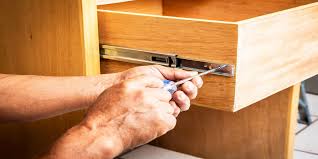Kitchen cabinets are not only essential for storage but also play a significant role in the overall aesthetics of your kitchen. Over time, wear and tear, as well as accidents, can take a toll on your cabinets, leaving them looking worn and dated. Fortunately, many common issues with kitchen cabinets can be repaired, saving you the cost and hassle of a full replacement. In this comprehensive guide, we’ll explore the complete process of kitchen cabinet repair, from identifying common problems to implementing effective solutions.
Table of Contents
ToggleIdentifying Common Problems
Before embarking on the repair process, it’s essential to identify the specific issues affecting your kitchen cabinets. Common problems include:
- Scratches and Scuffs: Surface scratches and scuffs are common on kitchen cabinets, especially in high-traffic areas. These imperfections can detract from the overall appearance of your cabinets and may require attention to restore their original finish.
- Loose or Broken Hardware: Over time, cabinet hardware such as hinges, handles, and knobs may become loose or break. Loose hardware can cause doors to sag or not close properly, affecting the functionality of your cabinets.
- Water Damage: Cabinets located near sinks or dishwashers are susceptible to water damage, which can cause warping, swelling, or discoloration of the wood or finish.
- Deteriorating Finish: The finish on kitchen cabinets can deteriorate over time due to exposure to heat, moisture, and sunlight. This can result in fading, peeling, or cracking of the finish, detracting from the appearance of the cabinets.
- Cabinet Door Misalignment: Improper installation or shifting of the cabinet structure can cause cabinet doors to become misaligned or uneven, resulting in gaps or overlaps between doors and frames.
Effective Solutions
- Repairing Surface Scratches: Minor scratches and scuffs can often be repaired using a wood touch-up pen or marker that matches the color of your cabinets. Simply apply the touch-up product to the affected area, following the grain of the wood, and allow it to dry before buffing away any excess.
- Tightening or Replacing Hardware: Check all cabinet hardware for looseness and tighten screws or bolts as needed. If hardware is damaged beyond repair, replace it with new hardware of the same size and style to ensure a secure fit and consistent appearance.
- Addressing Water Damage: For minor water damage, gently sand the affected area to remove any roughness or discoloration, then refinish the surface with a matching wood stain or paint. For more severe damage, such as warping or swelling, consider replacing the affected cabinet components.
- Refinishing Cabinet Finish: To restore the finish on kitchen cabinets, start by cleaning the surface with a mild detergent and water to remove dirt and grease buildup. Sand the cabinets lightly to remove any existing finish or imperfections, then apply a new coat of stain, paint, or varnish to achieve the desired look.
- Adjusting Cabinet Doors: To correct misaligned cabinet doors, adjust the hinges using a screwdriver to level the doors and ensure proper alignment. If necessary, install new hinges or hinge plates to achieve a secure and uniform fit.
Preventive Maintenance
Once you’ve completed the necessary repairs, it’s essential to implement preventive maintenance measures to prolong the life of your kitchen cabinets:
- Regular Cleaning: Clean your cabinets regularly with mild detergent and water to remove dirt, grease, and grime. Avoid using harsh chemicals or abrasive cleaners, as they can damage the finish.
- Protective Measures: Use coasters, placemats, and trivets to protect cabinet surfaces from heat, moisture, and scratches caused by hot pots, pans, and dishes.
- Proper Ventilation: Ensure adequate ventilation in your kitchen to prevent moisture buildup, which can lead to mold growth and damage to your cabinets.
- Routine Inspections: Periodically inspect your cabinets for signs of wear, damage, or deterioration, and address any issues promptly to prevent further damage. More Info
By following these steps, you can effectively repair and maintain your kitchen cabinets, restoring them to their former glory and ensuring years of reliable performance and aesthetic appeal. With a little time and effort, you can breathe new life into your kitchen cabinets and enhance the overall look and functionality of your kitchen space.



